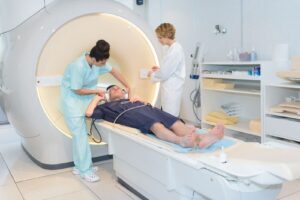Introduction:
An abdominal ultrasound is a noninvasive medical procedure that uses sound waves to create images of the organs inside your abdomen. It can help doctors diagnose a variety of conditions, including gallstones, kidney stones, abdominal masses, and tumors.
This article will explain what you can and cannot eat or drink before an abdominal ultrasound.
What is an abdominal ultrasound?
An abdominal ultrasound is a safe and painless medical procedure that uses sound waves to create images of the organs inside your abdomen. It can help doctors diagnose a variety of conditions, including gallstones, kidney stones, abdominal masses, and tumors.
Sometimes, an abdominal ultrasound can be used to prepare for surgery. It can also be used to monitor the progress of pregnancy or look for signs of infection.
Why might I need an abdominal ultrasound?
An abdominal ultrasound is a diagnostic imaging test that uses high-frequency sound waves to produce images of the internal organs and structures in the abdomen. An abdominal ultrasound is usually ordered by a doctor to evaluate the organs and structures in the abdomen, including the liver, gallbladder, bile ducts, pancreas, spleen, kidneys, and abdominal aorta.
Here are some common reasons why you might need an abdominal ultrasound:
- Abdominal pain: If you are experiencing abdominal pain, an abdominal ultrasound can help your doctor determine the cause of your symptoms.
- Liver problems: An abdominal ultrasound can help detect liver problems, such as liver disease, liver masses, and liver abnormalities.
- Gallbladder issues: An abdominal ultrasound can help diagnose gallstones, inflammation of the gallbladder (cholecystitis), or other gallbladder problems.
- Pancreatic problems: An abdominal ultrasound can help diagnose problems with the pancreas, such as pancreatitis or a mass in the pancreas.
- Kidney problems: An abdominal ultrasound can help diagnose kidney problems, such as kidney stones, tumors, or cysts.
- Abdominal aortic aneurysm: An abdominal ultrasound can help detect an aneurysm, which is a bulge in the wall of the aorta.
- Suspected abdominal mass: An abdominal ultrasound can help identify a mass or lump in the abdomen, which may be caused by a variety of conditions.
It’s important to note that an abdominal ultrasound is just one diagnostic tool and other tests may be needed to confirm or rule out certain conditions.
Why do you have to fast for an ultrasound?
Fasting before an abdominal ultrasound is typically recommended to help obtain clear images of the organs and structures in the abdomen. Fasting helps to reduce the amount of gas and fluid in the stomach and intestines, making it easier to see the organs more clearly.
When you eat, food and liquids move through your digestive system and create air and fluid in the stomach and intestines. This can make it more difficult for the ultrasound machine to produce clear images of the organs in the abdomen. By fasting, you can help ensure that the images are as clear as possible, which will help the doctor diagnose any underlying problems more accurately.
Typically, you will be asked to fast for 4 to 6 hours before an abdominal ultrasound. You should also avoid drinking liquids during this time, although you may be allowed to drink water. It’s important to follow your doctor’s instructions carefully and to inform them of any medications or supplements you are taking, as some of these may need to be discontinued temporarily before the test.
What are the risks of an abdominal ultrasound?
Abdominal ultrasound is generally considered a safe and noninvasive diagnostic test. There are few risks associated with this procedure, and it is well tolerated by most people.
However, as with any medical procedure, there are some potential risks and side effects that you should be aware of.
- Discomfort: Some people may experience some discomfort or mild pain during the procedure, especially if they have a full bladder. The discomfort is usually brief and goes away quickly.
- Allergic reactions: In rare cases, people may have an allergic reaction to the ultrasound gel used during the procedure. Symptoms of an allergic reaction can include itching, redness, or swelling at the site of the gel application.
- False results: Like with any diagnostic test, there is a small risk of false results with abdominal ultrasound. In some cases, the results may appear normal even if there is a problem, or they may show a problem that is not actually present.
- Need for additional tests: In some cases, the results of an abdominal ultrasound may be unclear or inconclusive, and additional tests may be necessary to confirm a diagnosis.
It’s important to keep in mind that these risks are relatively rare and that abdominal ultrasound is a safe and effective diagnostic tool for evaluating the organs and structures in the abdomen. If you have any concerns about the procedure, it’s important to discuss them with your doctor.
How is the abdominal ultrasound performed?
An abdominal ultrasound is typically performed as an outpatient procedure, and it usually takes about 30 to 60 minutes to complete. Here is what you can expect during the procedure:
Preparation
You will be asked to lie down on an examination table, and you may be asked to remove your clothes and wear a hospital gown. You may also be asked to empty your bladder before the procedure.
Gel application
A clear, water-based gel will be applied to your abdomen. This gel helps to improve the transmission of ultrasound waves and to produce clearer images.
Scanning
The ultrasound technologist will place a handheld device called a transducer against your skin and will move it back and forth over the area being examined. The transducer sends sound waves into your body, and the echoes are used to create images of the organs and structures in your abdomen.
Images
The images produced by the ultrasound machine will be displayed on a monitor, and the technologist or doctor may take photographs or video of the images for further analysis.
After the procedure
After the procedure, you can get dressed and go home. There is no special care or recovery time needed after an abdominal ultrasound. You can eat and drink normally, and you can return to your normal activities right away.
It’s important to remain still and to follow the instructions of the technologist or doctor during the procedure. An abdominal ultrasound is a safe and noninvasive procedure that can help your doctor diagnose a variety of conditions affecting the organs and structures in your abdomen.
How do I prepare for an abdominal ultrasound?
Preparation for an abdominal ultrasound is relatively simple and straightforward.
Here are some tips to help you prepare:
Follow instructions for fasting
You may be asked to fast for several hours before the procedure. You should also avoid drinking liquids during this time, although you may be allowed to drink water. It’s important to follow your doctor’s instructions carefully and to inform them of any medications or supplements you are taking, as some of these may need to be discontinued temporarily before the test.
Wear comfortable, loose clothing
You may be asked to remove your clothes and wear a hospital gown for the procedure. You should wear comfortable, loose clothing to the appointment, as tight clothing can interfere with the ultrasound waves and affect the quality of the images.
Empty your bladder
You may be asked to empty your bladder before the procedure, especially if you are having a pelvic ultrasound. This can help to produce clearer images of the organs in the lower abdomen.
Inform your doctor of any medications
Be sure to inform your doctor of any medications you are taking, as some of these may need to be discontinued temporarily before the test.
Inform your doctor of any allergies
If you have any allergies, be sure to inform your doctor, as you may be allergic to the ultrasound gel used during the procedure.
By following these tips, you can help to ensure that your abdominal ultrasound is as safe and effective as possible.
What happens during an abdominal ultrasound?
During the procedure, you will be asked to lie still so that the images produced by the ultrasound machine are as clear as possible. The procedure is painless, and there are no known risks associated with exposure to the low levels of ultrasound energy used during the test.
An abdominal ultrasound is a safe and effective way to evaluate the organs and structures in the abdomen, and it can help your doctor diagnose various conditions.
What happens after the test?
After an abdominal ultrasound, you can usually return to your normal activities right away. There is no special care or recovery time needed after the procedure.
Here’s what you can expect after the test:
Review of results
The results of your ultrasound will be reviewed by a radiologist, who will produce a report that will be sent to your doctor. Your doctor will then review the results with you and discuss any next steps or follow-up tests that may be necessary.
Normal activities
You can eat and drink normally after the test, and there are no restrictions on your activity. You can resume your normal activities, including work, exercise, and other daily routines.
Follow-up
If additional tests or treatments are needed, your doctor will discuss these with you and provide you with a plan for follow-up care.
Results
In some cases, the results of an abdominal ultrasound may be available within a few days. In other cases, it may take several days or more for the results to be available. Your doctor will be able to provide you with an estimate of when you can expect the results.
Have an Abdominal Ultrasound Today!
Now that you have enough information about abdominal ultrasounds, you can make an informed decision about whether this procedure is right for you. Be sure to follow your doctor’s instructions and to inform them of any medications or supplements you are taking, as these may need to be discontinued temporarily before the test.
At One Step Diagnostic, we care about your health and well-being. We offer abdominal ultrasound services to help you get the answers you need. Schedule an appointment with us today to get started! Our friendly and knowledgeable staff will be able to assist you throughout the examination process. Contact us for more information about our services or to book an appointment.




